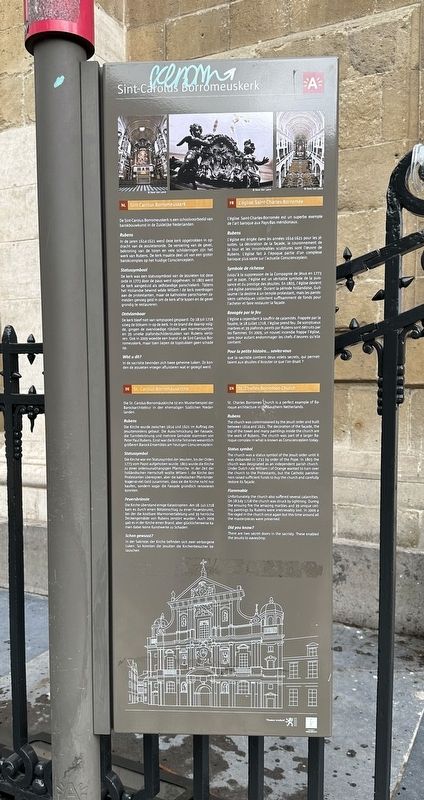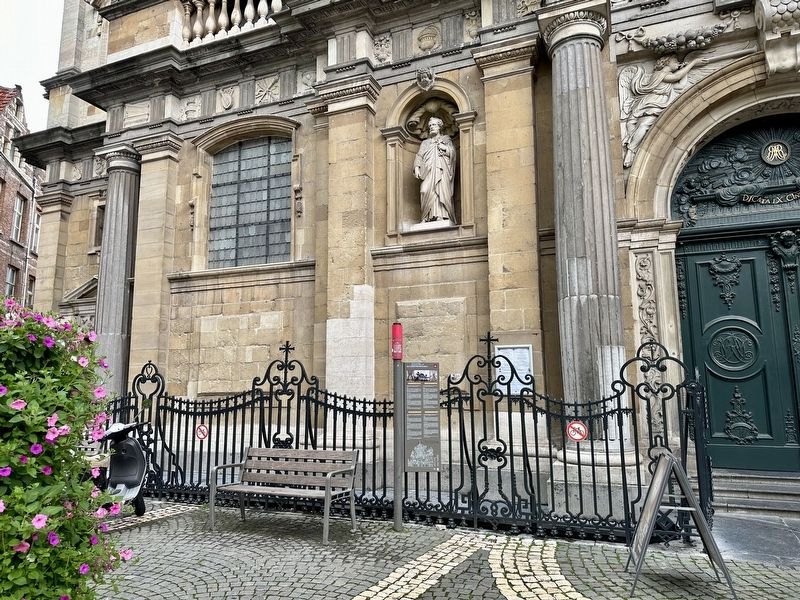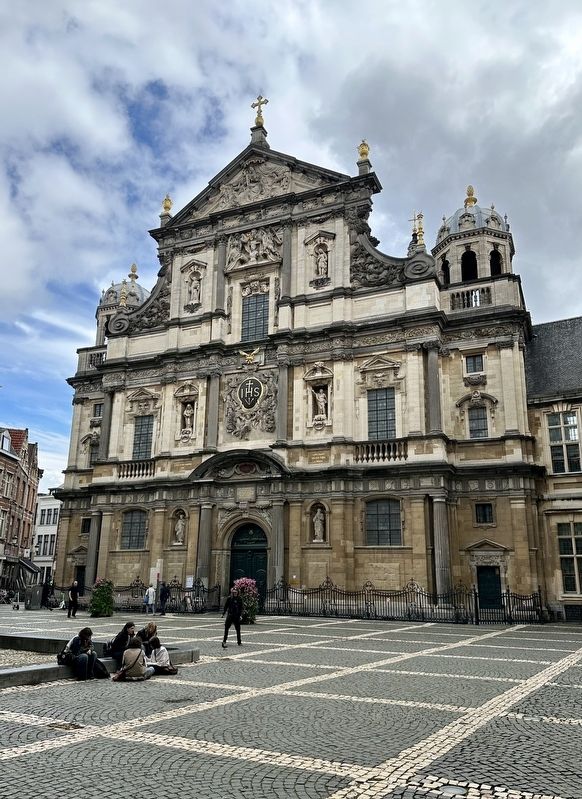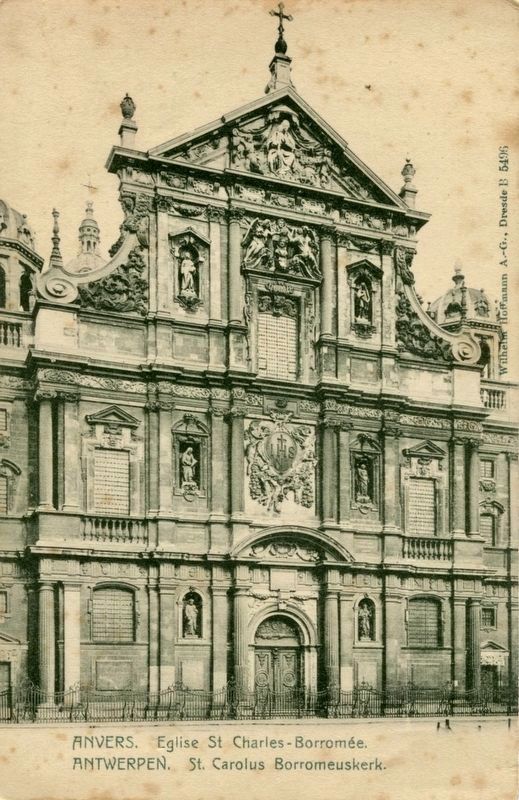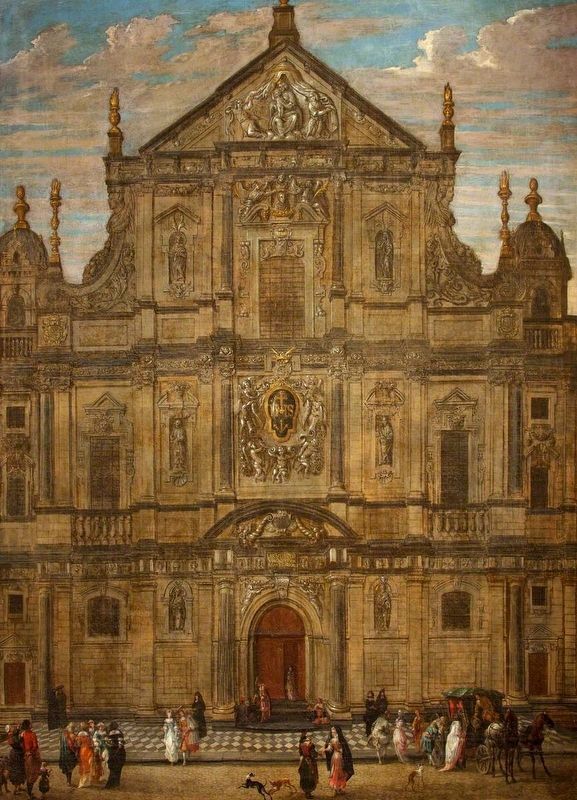Antwerpen, Flanders, Belgium — Northwestern Europe
Sint-Carolus Borromeuskerk / St. Charles Borromeo Church
St.-Carolus Borromäuskirche / L'église Saint-Charles-Borromée
Inscription.
NL Sint-Carolus Borromeuskerk
De Sint-Carolus Borromeuskerk is een schoolvoorbeeld van. barokbouwkunst in de Zuidelijke Nederlanden.
Rubens
In de jaren 1614-1621 werd deze kerk opgetrokken in opdracht van de jezuïetenorde. De versiering van de gevel, bekroning van de toren en vele schilderingen zijn het werk van Rubens. De kerk maakte deel uit van een groter barokcomplex op het huidige Conscienceplein.
Statussymbool
De kerk was een statussymbool van de jezuieten tot deze orde in 1773 door de paus werd opgeheven. In 1803 werd de kerk aangeduld als zelfstandige parochiekerk. Tijdens het Hollandse bewind wilde Willem I de kerk overdragen aan de protestanten, maar de katholieke parochianen za- melden genoeg geld in om de kerk af te kopen en de gevel grondig te restaureren.
Ontvlambaar
De kerk bleef niet van rampspoed gespaard. Op 18 juli 1718 sloeg de bliksem in op de kerk. In de brand die daarop volgde, gingen de overvloedige rijkdom aan marmersoorten en 39 unieke plafondschilderstukken van Rubens verlo ren. Ook in 2009 woedde een brand in de Sint-Carolus Bor romeuskerk, maar toen liepen de topstukken geen schade op.
Wist u dit?
In de sacristie bevinden zich twee geheime luiken. Zo kon den de jezuieten vroeger afluisteren wat er gezegd werd.
Die St.-Carolus-Borromäuskirche ist ein Musterbeispiel der Barockarchitektur in den ehemaligen Südlichen Niederlanden.
Rubens
Die Kirche wurde zwischen 1614 und 1621 im Auftrag des Jesuitenordens gebaut. Die Ausschmückung der Fassade, die Turmbekrönung und mehrere Gemalde stammen von Peter Paul Rubens. Einst war die Kirche Teil eines wesentlich großeren Barock-Ensembles am heutigen Conscienceplein.
Statussymbol
Die Kirche war ein Statussymbol der Jesuiten, bis der Orden 1773 vom Papst aufgehoben wurde. 1803 wurde die Kirche zu einer ordensunabhängigen Pfarrkirche. In der Zeit der holländischen Herrschaft wollte Willem I. die Kirche den Protestanten übereignen, aber die katholischen Pfarrkinder trugen so viel Geld zusammen, dass sie die Kirche nicht nur kaufen, sondern sogar die Fassade gründlich renovieren konnten.
Feuersbrünste
Die Kirche überstand einige Katastrophen. Am 18. Juli 1718 kam es durch einen Blitzeinschlag zu einer Feuersbrunst, bei der die kostbare Marmorvertäfelung und 39 herrliche Deckengemälde
von Rubens zerstört wurden. Auch 2009
gab es in der Kirche einen Brand, aber glücklicherweise ka
men dabei keine Kunstwerke zu Schaden.
Schon gewusst?
In der Sakristei der Kirche befinden sich zwei verborgene Luken. So konnten die jesuiten die Kirchenbesucher be Lauschen.
L'église Saint-Charles-Borromée est un superbe exemple de l'art baroque aux Pays-Bas méridionaux.
Rubens
L'église est érigée dans les années 1614-1621 pour les jé suites. La décoration de la façade, le couronnement de la tour et les innombrables sculptures sont l'oeuvre de Rubens. L'église fait à l'époque partie d'un complexe baroque plus vaste sur l'actuelle Conscienceplein.
Symbole de richesse
Jusqu'à la suppression de la Compagnie de Jésus en 1773 par le pape, l'église est un véritable symbole de la puissance et du prestige des jésuites. En 1803, l'église devient une église paroissiale. Durant la période hollandaise, Guillaume I la destine à un temple protestant, mais les paroissiens catholiques collectent suffisamment de fonds pour l'acheter et faire restaurer la façade..
Ravagée par le feu
L'église a cependant à souffrir de calamités. Frappée par la foudre, le 18 juillet 1718, l'église prend feu. De somptueux marbres et 39 plafonds
peints par Rubens sont détruits par
les flammes. En 2009, un nouvel incendie frappe l'église,
sans pour autant endommager les chefs d'oeuvres qu'elle
contient.
Pour la petite histoire... saviez-vous
que la sacristie contient deux volets secrets, qui permettaient aux jésuites d'écouter ce que l'on disait ?
St. Charles Borromeo Church is a perfect example of Baroque architecture in the Southern Netherlands.
Rubens
The church was commissioned by the Jesuit order and built between 1614 and 1621. The decoration of the façade, the top of the tower and many paintings inside the church are the work of Rubens. The church was part of a larger Baroque complex in what is known as Conscienceplein today.
Status symbol
The church was a status symbol of the Jesuit order until it was disbanded in 1733 by order of the Pope. In 1803 the church was designated as an independent parish church. Under Dutch rule William I of Orange wanted to turn over the church to the Protestants, but the Catholic parishioners raised sufficient funds to buy the church and carefully restore its façade.
Flammable
Unfortunately the church also suffered several calamities. On 18 July 1718 the church was struck by lightning. During the ensuing fire the amazing
marbles and 39 unique ceiling paintings by Rubens were irretrievably lost. In 2009 a
fire raged in the church once again but this time around all
the masterpieces were preserved.
Did you know?
There are two secret doors in the sacristy. These enabled the Jesuits to eavesdrop.
Topics. This historical marker is listed in these topic lists: Architecture • Arts, Letters, Music • Churches & Religion. A significant historical date for this entry is July 18, 1718.
Location. 51° 13.259′ N, 4° 24.262′ E. Marker is in Antwerpen, Vlaams Gewest (Flanders). Marker is on Hendrik Conscienceplein. Touch for map. Marker is at or near this postal address: Hendrik Conscienceplein 7, Antwerpen, Vlaams Gewest 2000, Belgium. Touch for directions.
Other nearby markers. At least 8 other markers are within walking distance of this marker. Albrecht Duerer (1471-1528) (within shouting distance of this marker); Sint-Annagodshuis / Saint Anne Almshouse (about 90 meters away, measured in a direct line); Handelsbeurs / Stock Exchange (approx. 0.3 kilometers away); Antoon van Dijck (approx. 0.4 kilometers away); Vleeshuis / Das Fleischhaus / La Halle des Bouchers / Butchers’ Hall (approx. 0.4 kilometers away); Ruihuis (approx. 0.4 kilometers away); Antwerpen anno 1750 / Antwerp in 1750 (approx. 0.4 kilometers away); Snoepje Napoleon / Napoleon Candy (approx. half a kilometer away). Touch for a list and map of all markers in Antwerpen.
Also see . . .
St. Charles Borromeo Church, Antwerp (Wikipedia).
Overview: St. Charles Borromeo Church (Dutch: Sint-Carolus Borromeuskerk) is a church in central Antwerp, located on the Hendrik Conscience square. It was built in 1615-1621 as the Jesuit church of Antwerp, which was closed in 1773. It was rededicated in 1779 to Saint Charles Borromeo. The church was formerly known for 39 ceiling pieces by Rubens that were lost in a fire when lightning struck the church on 18 July 1718.(Submitted on June 11, 2023.)
Credits. This page was last revised on December 31, 2023. It was originally submitted on June 11, 2023, by Andrew Ruppenstein of Lamorinda, California. This page has been viewed 87 times since then and 20 times this year. Photos: 1, 2, 3, 4, 5. submitted on June 11, 2023, by Andrew Ruppenstein of Lamorinda, California.
